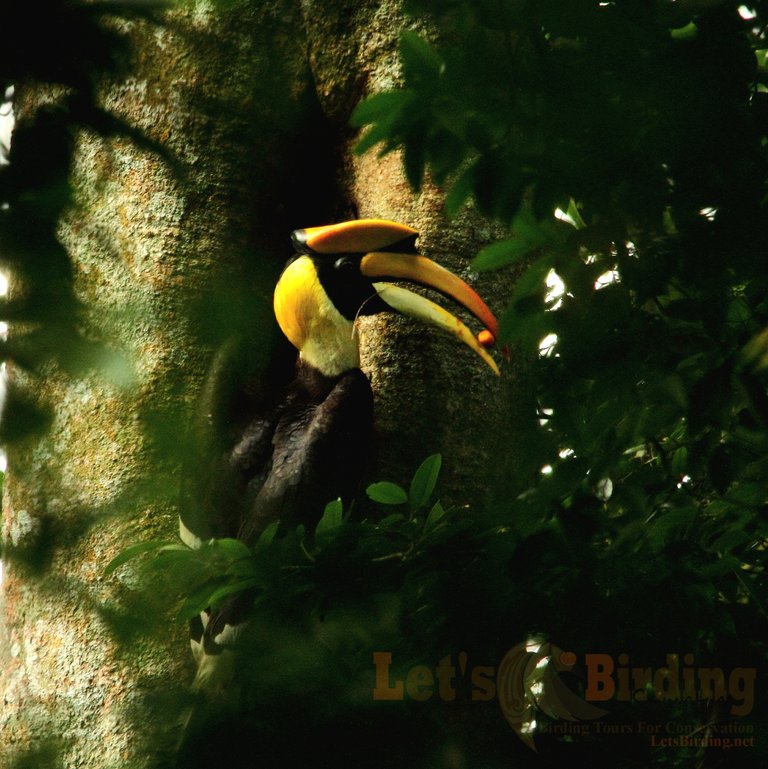| English Name | Latiin Name | Link |
|---|---|---|
| Great Hornbill | Buceros bicornis | https://www.inaturalist.org/observations/253847895 |

Sumatra has a rich diversity of fauna and flora species, one of which is the Great Hornbill (Buceros bicornis). This hornbill species is the largest and most striking bird in the Bucerotidae family. With a body size that can reach a length of 1.3 meters and weigh up to 4 kg, this bird is known for its large beak and bright colors on its body.

The Great Hornbill has a large beak with an additional structure on the top called a "casque". This casque is often bright yellow, the result of the bird's habit of rubbing its beak on an oil gland at the base of its tail. Its body is decorated with black feathers with white patterns on the wings and tail, creating a very striking appearance when flying.
This bird is famous for its loud call and distinctive wing flapping sound, which can be heard up to several hundred meters away. The Great Hornbill is a species that is very loyal to its partner, forming monogamous pairs that last a lifetime. During the nesting season, the female will lock herself in a tree hole and rely entirely on the male to provide food.
This bird lives in tropical and subtropical rainforests, usually at altitudes of 500-2,000 meters. They play an important role in the ecosystem as seed dispersers. Fruits, especially from Dipterocarpaceae tree species are their main food, although they also eat insects and small animals.
With the ability to disperse seeds over large areas, the Great Hornbill helps maintain the sustainability of tropical forests, making it a keystone species in the ecosystems where they live. So this species is also known as the forest farmer.
Despite its important ecological role, the Great Hornbill faces various threats, such as habitat loss due to deforestation, poaching for its beak and casque, and capture for the wildlife trade. Its status is now categorized as "Vulnerable" by the IUCN (International Union for Conservation of Nature).
Several conservation measures have been taken, such as habitat preservation, hunting bans, and community education programs. In some places, the Great Hornbill is also a symbol of forest conservation, emphasizing the importance of protecting tropical forests as a home for this species.
Conserving the Great Hornbill is not just about protecting a charismatic species, but also about maintaining the balance of the tropical forest ecosystem. This bird is an indicator of forest health. Its loss can have a major impact on the sustainability of the forest that supports many other species, including humans.
With more awareness and collective action, we can ensure that the Great Hornbill continues to soar freely in the tropical forest skies for generations to come.
| Camera | Lens | Location |
|---|---|---|
| Canon 60D | Sigma 150-500 mm | Aceh, Sumatra, Indonesia. |
Congratulations @tediwahyudi! You have completed the following achievement on the Hive blockchain And have been rewarded with New badge(s)
You can view your badges on your board and compare yourself to others in the Ranking
If you no longer want to receive notifications, reply to this comment with the word
STOPCheck out our last posts:
!discovery 30
Thank you 🙏
This post was shared and voted inside the discord by the curators team of discovery-it
Join our Community and follow our Curation Trail
Discovery-it is also a Witness, vote for us here
Delegate to us for passive income. Check our 80% fee-back Program
Thank you 🙏
Unique bird, in its head there is a topic. I've never seen this bird before, thanks for sharing.
Thank you very much 🙏
We have these here in India too towards the south in a quite green spot called Dandeli. I want to see this bird one day though I'm quite familiar with the grey hornbill in our farm.